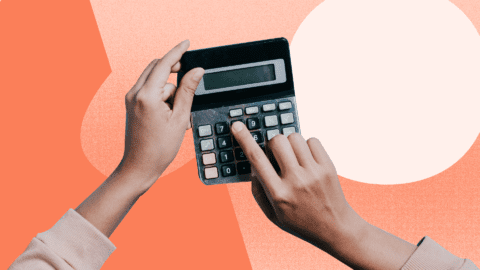🔢 Fraction ↔ Decimal Calculator
Enter Fraction
📚 Instructions:
- Fraction → Decimal: Convert fractions to decimal format with step-by-step process
- Decimal → Fraction: Convert decimals to simplified fractions
- Mixed Numbers: Work with mixed numbers (e.g., 2¾) and decimals
- Simplify: Reduce fractions to lowest terms
- Operations: Add, subtract, multiply, and divide fractions
- Compare: Determine which fractions are larger or smaller
- Equivalent: Find fractions equal to a given fraction
- Percentage: Convert between fractions, decimals, and percentages
- Repeating: Handle repeating decimals with proper notation
- Rounding: Round decimals to specified decimal places
- Complete Analysis: Get all conversions and properties in one report
Converting Decimals and Fractions: Your Questions Answered
How to Convert a Decimal to a Fraction? (Terminating Decimals)
Converting a terminating decimal (a decimal that ends) to a fraction involves these steps:
- Write down the decimal as the numerator of the fraction (without the decimal point).
- The denominator is a power of 10. The number of zeros in the denominator is equal to the number of digits after the decimal point in the original decimal.
- If there's 1 digit after the decimal, the denominator is 10.
- If there are 2 digits after the decimal, the denominator is 100.
- If there are 3 digits after the decimal, the denominator is 1000, and so on.
- Simplify the fraction to its lowest terms by dividing both the numerator and the denominator by their greatest common divisor (GCD).
Example 1: Convert 0.75 to a fraction.
- Numerator: 75
- Denominator: There are 2 digits after the decimal, so the denominator is 100. Fraction is
75/100. - Simplify: The GCD of 75 and 100 is 25.
75 ÷ 25 = 3
100 ÷ 25 = 4
So, 0.75 = 3/4.
Example 2: Convert 0.6 to a fraction.
- Numerator: 6
- Denominator: 1 digit after decimal, so 10. Fraction is
6/10. - Simplify: GCD of 6 and 10 is 2.
6 ÷ 2 = 3
10 ÷ 2 = 5
So, 0.6 = 3/5.
Example 3: Convert 2.4 to a fraction (or mixed number).
- Consider the decimal part: 0.4. Numerator is 4, denominator is 10. Fraction is
4/10. - Simplify
4/10to2/5. - Combine with the whole number part: 2.4 = 2 and 2/5. (As an improper fraction:
(2*5+2)/5 = 12/5)
This process answers: "how to convert decimal to fraction," "how to turn a decimal into a fraction," "how to make a decimal into a fraction," "how to convert decimals to fractions," "how to turn decimals into fractions," "how to change a decimal to a fraction," "how do you convert a decimal to a fraction," "how to change decimal to fraction," "how to convert a decimal to a fraction," "how to go from decimal to fraction," "how to write a decimal as a fraction," "how to turn decimal into fraction," "how to convert the decimal to fraction," "how to write decimals as fractions," "how to convert decimal into fraction," "how to convert decimals into fractions," "how to convert a decimal into a fraction," "how to express a decimal as a fraction," "how to make decimals into fractions," "how to calculate decimal to fraction," "how to make a decimal a fraction," "how to turn a decimal intoa fraction" (common typo), "how to turn decimal to fraction," "how do i convert a decimal to a fraction," "how do you convert decimals to fractions," "how to convert from decimal to fraction," "how do you turn a decimal to a fraction," "how to write a decimal as fraction," "how to write decimals in fraction form," and "how to change decimal into fraction."
"How to convert decimal to mixed fraction" is shown in Example 3 above.
How to Convert a Repeating Decimal to a Fraction? (Infinite Decimals)
Converting a repeating (or recurring) decimal to a fraction requires a bit more algebra:
For a simple repeating decimal (e.g., 0.333... or 0.777...):
- Let
xequal the repeating decimal. - Multiply
xby a power of 10 so that the repeating block of digits shifts to the left of the decimal point. If one digit repeats, multiply by 10. If two digits repeat, multiply by 100, etc. - Subtract the original equation (
x = ...) from the new equation. This should eliminate the repeating decimal part. - Solve for
xand simplify the resulting fraction.
Example: Convert 0.777... to a fraction.
- Let
x = 0.777... - One digit repeats, so multiply by 10:
10x = 7.777... - Subtract the first equation from the second:
10x = 7.777...
- x = 0.777...
-----------------
9x = 7 - Solve for
x:x = 7/9. - So, 0.777... = 7/9.
For a mixed repeating decimal (e.g., 0.1232323... where '1' doesn't repeat but '23' does):
- Let
xequal the repeating decimal. - Multiply
xby a power of 10 to move the non-repeating part to the left of the decimal point. - Multiply
xby another (larger) power of 10 to move one full repeating block to the left of the decimal point. - Subtract the smaller equation from the larger equation.
- Solve for
xand simplify.
This more complex method answers: "how to turn a repeating decimal into a fraction," "how do i change a repeating decimal to a fraction," "how to change a repeating decimal to a fraction," "how to change repeating decimals into fractions," "how to convert repeating decimals into fractions," "how to convert repeating decimals to fractions," "how do you change a repeating decimal to a fraction," "how do you convert a repeating decimal to a fraction," "how to convert a repeating decimal to a fraction," "how to convert repeating decimal to fraction," "how to write a repeating decimal as a fraction," "how do you convert a repeating decimal to fraction," "how to convert an infinite decimal to a fraction," and "how to convert infinite decimals to fractions," "how to convert recurring decimals to fractions."
How to Convert a Fraction to a Decimal?
To convert a fraction to a decimal, you simply divide the numerator by the denominator.
- Perform long division, with the numerator inside the division symbol (the dividend) and the denominator outside (the divisor).
- Add a decimal point and zeros to the numerator as needed to continue the division until it either terminates (ends with a remainder of 0) or a repeating pattern of digits emerges.
Example 1: Convert 3/4 to a decimal.
Divide 3 by 4: 3 ÷ 4 = 0.75.
So, 3/4 = 0.75.
Example 2: Convert 2/3 to a decimal.
Divide 2 by 3: 2 ÷ 3 = 0.666... (the 6 repeats infinitely).
This is often written as 0.6̅.
So, 2/3 = 0.666... or 0.6̅.
This process answers: "how to convert fractions to decimals," "how to turn a fraction into a decimal," "how do you convert a fraction to a decimal," "how to change a fraction to a decimal," "how to convert a fraction to a decimal," "how to make a fraction into a decimal," "how to turn fractions into decimals," "how to turn fraction into decimal," "how to convert fraction to decimal," "how to make fractions into decimals," "how to switch fractions to decimals," "how to write fractions as decimals," "how to change fractions to decimals," "how to transfer fractions to decimals," "how to convert a fraction into a decimal," "how to change a fraction into a decimal," "how to change fraction to decimal," "how to convert fractions into decimals," "how to turn fractions to decimals," "how to make a fraction a decimal," "how to turn a fraction to a decimal," "how to write a fraction as a decimal," "how do i convert a fraction to a decimal," "how do you change a fraction to a decimal," "how to find the decimal of a fraction," "how to make fractions decimals," "how to write fractions into decimals," "how do you convert fractions to decimals," "how to change fraction into decimal," "how to convert fraction into decimal," "how to fraction to decimal," "how to make fraction into decimal," "how do you write a fraction to a decimal," and "how to turn fraction to decimal."
How to Convert a Mixed Fraction to a Decimal?
There are two main ways:
- Convert the fractional part to a decimal and add it to the whole number.
- Example: Convert 2 and 3/4 to a decimal.
- Convert 3/4 to a decimal:
3 ÷ 4 = 0.75. - Add the whole number:
2 + 0.75 = 2.75. - So, 2 and 3/4 = 2.75.
- Convert 3/4 to a decimal:
- Example: Convert 2 and 3/4 to a decimal.
- Convert the mixed fraction to an improper fraction first, then divide.
- Example: Convert 2 and 3/4 to an improper fraction:
(2 × 4 + 3) / 4 = (8 + 3) / 4 = 11/4. - Convert the improper fraction to a decimal:
11 ÷ 4 = 2.75. - So, 2 and 3/4 = 2.75.
- Example: Convert 2 and 3/4 to an improper fraction:
This answers: "how to turn a mixed fraction into a decimal," "how to change a mixed fraction into a decimal," "how to convert mixed fraction to decimal," and "how to convert a mixed fraction into a decimal."
How to Convert Fractions to Decimals Without a Calculator?
This involves performing long division manually, as described in the "How to Convert a Fraction to a Decimal?" section. You place the numerator inside the division bracket and the denominator outside, then carry out the division, adding decimal points and zeros as needed.
Example: Convert 5/8 without a calculator.
0.625
_______
8 | 5.000
-0
---
5 0 (Bring down 0)
-4 8 (8 x 6 = 48)
----
20 (Bring down 0)
-16 (8 x 2 = 16)
----
40 (Bring down 0)
-40 (8 x 5 = 40)
----
0 (Remainder is 0, so it terminates)
So, 5/8 = 0.625.
This directly addresses: "how to convert fraction to decimal without calculator," "how to convert fractions to decimals without a calculator," "how do you convert fractions to decimals without a calculator," "how to change fraction to decimal without calculator," and "how to change fractions into decimals without a calculator."
How to Use a Calculator for Conversions?
Fraction to Decimal on a Calculator:
- Most basic calculators: Simply enter the numerator, press the division button (÷), enter the denominator, and press the equals button (=). The display will show the decimal equivalent.
- Some scientific or graphing calculators have a dedicated fraction button (often looking like
a b/cor▢/▢). You can enter the fraction directly and then press a button to convert it to decimal (often labeled F⇔D, →DEC, or similar).
Decimal to Fraction on a Calculator (Scientific/Graphing Calculators):
- Enter the decimal.
- Look for a function or button that converts decimals to fractions. This might be an "S⇔D" (Standard to Decimal, or vice-versa), "F⇔D", or a menu option. The calculator will attempt to display the decimal as a simplified fraction.
- Note: Basic four-function calculators typically cannot convert decimals to fractions automatically.
This covers: "how to convert fractions into decimals on a calculator," "how to make fraction to decimal in calculator," and "how to turn decimal into fraction on calculator," "how to convert decimal to fraction on calculator."
General Combined Question:
"How to convert decimals to fractions and fractions to decimals" is answered by combining the methods described above for each individual conversion type.
Key Understanding: Decimals and fractions are simply different ways to represent numbers that are not whole. Being able to convert between them is a fundamental skill in mathematics, useful in many real-world situations and for further math studies.

